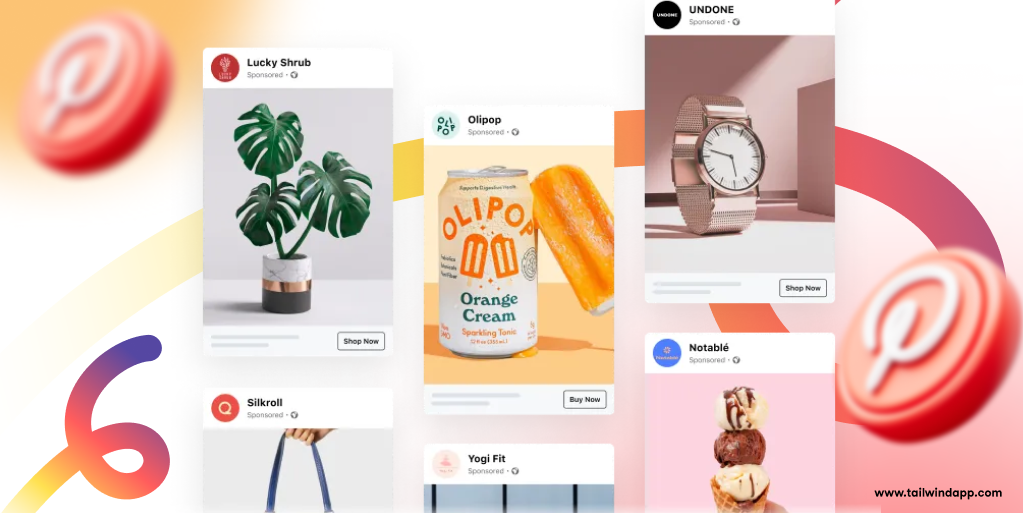
Remember when Pinterest felt like a peaceful corner of the internet where you could scroll through beautiful images and inspiring ideas without being constantly sold to?
Those days are long gone. If you’ve noticed that your Pinterest feed seems packed with more ads than ever before, you’re absolutely right.
Pinterest has transformed from a simple inspiration board into a sophisticated discovery engine that’s laser-focused on connecting users with products and services they might actually buy.
This evolution has been years in the making, but 2025 represents a significant acceleration of Pinterest’s monetization efforts. The platform now operates more like a visual search engine than traditional social media, which means the ads you see are often more targeted and relevant than ever before.
While this change can feel overwhelming, understanding why it’s happening and what limited controls you have can help you navigate this new Pinterest landscape more effectively. Let’s dive into what’s really going on behind the scenes and what you can actually do about it.
Pinterest Ads Explained – What Counts as an “Ad”?
Not everything that feels like an ad on Pinterest is technically advertising, so let’s clarify what we’re actually dealing with.
Promoted Pins are the primary form of advertising on Pinterest. These are posts that businesses pay to show to specific audiences based on interests, demographics, and behavior patterns.
These Promoted Pins are designed to look almost identical to organic content, which is why they can feel so seamless (and sometimes sneaky). You’ll typically see a small “Promoted” label, but it’s often subtle enough that many users scroll right past without noticing it’s paid content.
Pinterest offers several ad formats that might be appearing in your feed. Static image ads are the most common, featuring a single image with text overlay and a link to a website or product page.
Video ads have become increasingly popular, especially short-form content that plays automatically as you scroll. Carousel ads allow businesses to showcase multiple products or ideas within a single ad unit, letting users swipe through different images or videos.
What makes Pinterest advertising particularly effective (and potentially overwhelming) is how naturally it blends with organic content.
Unlike banner ads or pop-ups, Promoted Pins are designed to provide genuine value and inspiration while subtly encouraging users to take action. This approach means you might engage with ads without even realizing they’re advertisements.
Pinterest’s algorithm has become incredibly sophisticated at determining which ads to show you based on your behavior patterns. The platform tracks not just what you save and search for, but how long you spend looking at certain types of content, what you do after viewing Pins, and even seasonal patterns in your activity.
While it’s easy to feel overwhelmed by the number of ads, it’s worth noting that many Pinterest users actually benefit from Promoted content — especially when they’re actively researching a purchase. Whether you’re planning a home renovation, browsing outfit ideas for an event, or shopping for unique gifts, the right ad can surface exactly what you’re looking for without needing to leave the platform. Pinterest ads are often highly relevant because they’re matched to your interests and recent activity, which means they can act more like helpful suggestions than disruptive promotions. When you’re in a discovery mindset, ads can help streamline your search and introduce new products or brands that align with your goals.
Why Pinterest Ads Have Increased in 2025
- E-commerce activity on Pinterest has increased as more people use the platform for actual shopping rather than just inspiration.
- When users save products, click through to purchase, and use Pinterest to research buying decisions, it creates a goldmine of intent data that advertisers are eager to tap into.
- The platform went public in 2019 and has been under increasing pressure to demonstrate strong revenue growth to investors.
- Advertising revenue is Pinterest’s primary income source, so expanding ad inventory and improving targeting capabilities has become a top priority.
- The platform’s artificial intelligence has become much more sophisticated at placing ads in front of users who are most likely to engage with them. This AI-driven approach means ads are more targeted than ever before, but it also means Pinterest is showing ads more frequently because they’re more likely to generate clicks and conversions.
- More brands have recognized Pinterest’s unique position in the customer journey. Unlike other social platforms where advertising can feel intrusive, Pinterest users are actively seeking ideas and solutions. This makes Pinterest advertising feel more natural and less disruptive, encouraging more businesses to invest in Pinterest campaigns.
- The Pinterest Trends tool has also influenced ad targeting by helping businesses understand what users are actively searching for and interested in. This data allows advertisers to create more relevant campaigns that align with current user interests and seasonal trends.
- The mobile-first approach has also contributed to increased advertising. With most Pinterest users accessing the platform via mobile devices, Pinterest has optimized ad delivery for smartphone users, often making ads feel more immersive and harder to ignore compared to desktop advertising.
What You Can Control in Your Pinterest Ad Experience
While Pinterest doesn’t offer a way to completely disable ads, you do have some limited controls over your advertising experience that can help reduce the overwhelm.
Edit Your Pinterest Ad Personalization Settings
Pinterest allows you to adjust how your data is used for ad targeting, though these controls are somewhat limited. You can access these settings by going to your account settings and looking for privacy or ad preferences sections.
Step 1: Go to ‘Settings’.
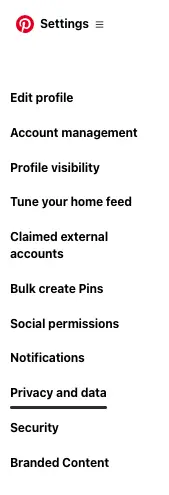
Step 2: Choose what Pinterest will share with advertisers.
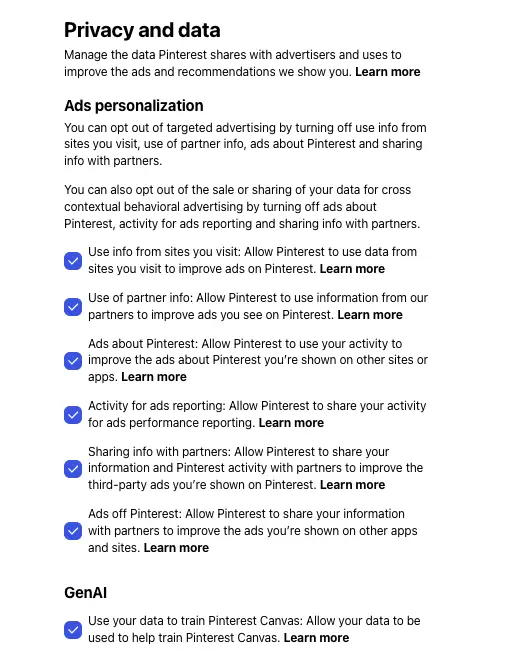
In your personalization settings — called ‘Tune Your Home Feed’ — you can remove interest categories that Pinterest has automatically assigned to your profile based on your activity. If Pinterest thinks you’re interested in home decor because you saved some kitchen inspiration, but you’re actually not shopping for home goods, you can remove that category.
Step 1: Go to ‘Tune Your Home Feed’.
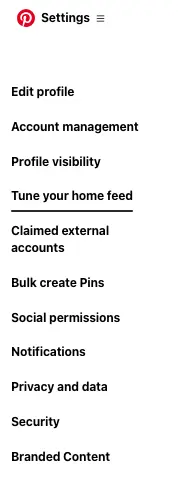
Step 2: Adjust the interests, activities, boards and following information Pinterest has stored for your account.
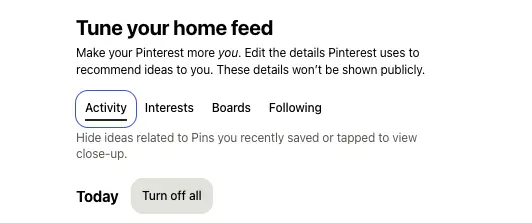
You can also limit how Pinterest uses your off-platform activity for ad targeting. This includes data from websites you visit that have Pinterest tracking pixels, as well as information Pinterest might receive from data partners. While this won’t eliminate ads, it can make them feel less creepily targeted.
However, it’s important to understand the limitations of these controls. Pinterest’s algorithm is constantly learning from your behavior, so even if you adjust your settings, your ongoing activity will continue to influence the ads you see. Additionally, some core targeting based on your Pinterest activity (like what you save and search for) can’t be completely disabled.
Mark Ads as Irrelevant or Repetitive
One of the most effective tools at your disposal is providing feedback directly on ads that don’t interest you. When you see a Promoted Pin that feels irrelevant or repetitive, you can tap the three dots in the corner and select options like “Hide this ad” or “Not relevant.”
This feedback helps Pinterest understand what you don’t want to see and can reduce similar ads in the future. If you consistently mark certain types of ads as irrelevant, Pinterest’s algorithm will learn to show you fewer ads in those categories.
You can also report ads that feel inappropriate or misleading, which helps Pinterest maintain quality standards for advertising on the platform. While this doesn’t reduce the total number of ads you see, it can improve the overall quality of your ad experience.
The key is being consistent with your feedback. If you take the time to mark irrelevant ads every time you see them, you should notice an improvement in ad relevance over time, though it may take several weeks for the algorithm to fully adjust.
What You Can’t Change: The Limits of Pinterest Ad Blocking
It’s important to set realistic expectations about what you can and can’t control when it comes to Pinterest advertising. Pinterest has made it clear that ads are a fundamental part of the platform experience, and they don’t offer an ad-free subscription tier or complete opt-out option.
Browser ad blockers can help reduce some Pinterest ads when you’re using the platform on desktop, but their effectiveness is limited and constantly changing. Pinterest regularly updates how they deliver ads, which can temporarily reduce ad blocker effectiveness until the extensions catch up with new formats.
Mobile users have even fewer options since most ad blockers don’t work within mobile apps. Given that the majority of Pinterest users access the platform via mobile devices, this limitation affects most people’s Pinterest experience.
Pinterest’s business model fundamentally depends on advertising revenue, and this isn’t likely to change. As a free platform, Pinterest needs advertising income to support its operations, pay content creators, and continue developing new features. This means that any controls Pinterest offers will always be limited in scope.
Final Thoughts – How to Make Pinterest Useful Again
Despite the increased advertising presence, Pinterest can still be an incredibly valuable tool for inspiration and discovery; you just need to be more intentional about how you use it.
Start by being more selective about what you save and search for, understanding that this activity directly influences the ads you see. If you’re tired of seeing home decor ads, avoid saving home-related content for a while and focus on other interests instead.
Regular maintenance of your ad settings can help keep your advertising experience manageable. Set a monthly reminder to review your personalization settings, remove interest categories that no longer apply, and mark irrelevant ads when you encounter them.
Frequently Asked Questions
Why does Pinterest have so many ads now compared to before?
Pinterest has shifted from a simple inspiration platform to a monetized discovery engine. The platform went public in 2019 and has been under pressure to increase advertising revenue, leading to more Promoted Pins and better targeting capabilities.
Can I pay to remove ads from Pinterest?
No, Pinterest doesn’t offer a paid ad-free subscription tier. Unlike some platforms, Pinterest’s business model relies entirely on advertising revenue, so they haven’t created an option to pay for an ad-free experience.
Do Pinterest ads track me across other websites?
Pinterest uses tracking pixels and data partnerships to understand your activity on other websites, which helps them target ads more effectively. You can limit some of this tracking through your privacy settings, but not eliminate it entirely.
How do I control what Pinterest knows about me for ads?
You can adjust your ad personalization settings by going to your Pinterest account settings, then choosing Privacy and Data. There, you can limit how Pinterest uses your off-platform activity and opt out of certain data sharing with advertisers. This can help reduce how precisely ads are targeted to your browsing behavior.
How do I remove interests, boards, and following info from Pinterest?
Go to the Tune Your Home Feed settings in your account. This lets you review and remove:
- Interest categories Pinterest has assigned to you
- Boards and Pins influencing your feed
- Topics based on your search and save behavior
- People and brands you’re following
Clearing or updating these areas can significantly change what appears in your feed, including the types of ads you see. Pinterest will continue learning from your future activity, so revisiting these settings regularly is a good idea.
Is my information private on Pinterest?
Pinterest collects and uses your activity on and off the platform to personalize your experience, especially when it comes to ads and content recommendations. While Pinterest doesn’t sell your personal information, it does use your behavior — like what you save, search, or click — to build a profile that informs what you see.
You can adjust some privacy settings, such as whether Pinterest can use your activity from other websites (via tracking pixels) or share data with ad partners. Go to Settings → Privacy and Data to review these options. However, your core Pinterest activity — like your searches, saves, and engagement on Pins — is always used to personalize your experience and can’t be fully hidden or deleted from the algorithm.
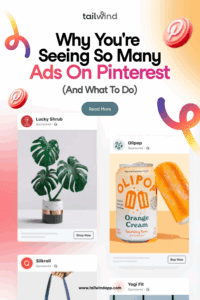
The post Why You’re Seeing So Many Ads on Pinterest (And What to Do) appeared first on Tailwind Blog.













